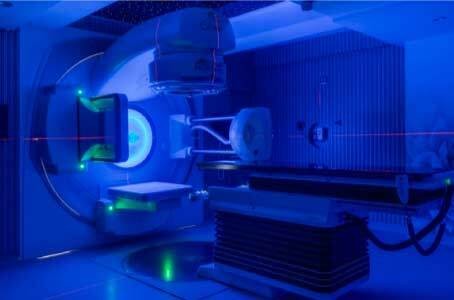There are two types of radiotherapy:
- External beam radiation therapy (EBRT)
- Brachytherapy (Internal Radiation therapy)
Types of radiation therapy services available at MGM Cancer Institute
- 3DCRT (Conformal radiation therapy)
- IMRT(Intensity Modulated radiation therapy)
- VMAT(Volumetric modulated arc therapy)
- SRS(Stereotactic radiosurgery)
- IGRT(Image guided radiation therapy)
- RGRT(Respiratory gated radiation therapy)
- SRT(Stereotactic radiotherapy)
- SBRT(Stereotactic body radiation therapy)

Fact Check
Radiotherapy is non-invasive and hassle free. Most patients receiving radiotherapy can still carry on with daily routines like going to work, running errands etc

How radiation therapy is used in cancer patients
Radiotherapy may be recommended by your doctor at various points during your cancer treatment for a variety of reasons, including:
- As the only (primary) cancer treatment. Eg; cervix, head & neck cancers, etc.,
- To shrink a cancerous tumour before surgery (neoadjuvant therapy) eg; Carcinoma rectum, etc
- To halt the growth of any remaining cancer cells after surgery (adjuvant therapy) eg; Breast cancer, uterine cancer, etc.,
- In advanced cancer, to alleviate cancer-related symptoms. Eg; Metastatic cancers
Adverse effects
Some side effects to watch out for

Skin irritation
The area of the body being treated with radiation therapy may become red, dry, and itchy. The skin may also become more sensitive to the sun.

Nausea and vomiting
Some patients may experience nausea and vomiting during or after treatment.

Loss of appetite
Some patients may lose their appetite during treatment.

Diarrhoea
Some patients may experience diarrhoea during treatment.

Hair loss
Radiation therapy to the head or neck may cause hair loss in the treated area.

Swelling and discomfort
If radiation therapy is delivered to the breast, it may cause swelling and discomfort in the breast and armpit.
It’s important to note that these side effects are generally temporary and can be managed with medication and other treatments. Your doctor or radiation oncologist will provide you with more information about the potential side effects of your treatment and how they can be managed.
A Positive note for preparation

How can you prepare?
Our Radiation Oncology team will walk you through the entire process before you receive Radiotherapy.
Immobilisation: Immobilization devices such as aquaplast moulds, casts, and headrests are used in radiation therapy to make sure that the patient stays in the correct position over the course of treatment. If a patient is not immobilised properly, then he/she is at risk for improper treatment and unwanted side effects.
Planning Computed Tomography (CT) scan: To determine the exact location of the cancer affected area to be treated, you will have to undergo CT scans.
Radiotherapy Treatment planning & Quality Assurance (QA): The acquired CT images will be transferred to advanced algorithm based treatment planning software systems for accurate radiation dose calculations and dose evaluation. This process achieves the aim of Radiotherapy by delivering the maximum dose to the tumour and minimum dose to normal tissues
Treatment Execution:
Finally, after passing QA criteria specified by the Medical Physicists, the plan will be approved for treatment execution by the skilled and experienced Radiotherapy Technologists. However, the first day treatment setup will be supervised by a Radiation Oncologist and Medical Physicist. During the treatment the Linac moves around as you lie on a table, delivering radiation from various angles through the dynamically modified apertures to deliver the radiation precisely.
During the treatment delivery:
External beam radiation is generally delivered as an outpatient procedure, 5 days/ week for a set period of time.
Each treatment session should last between 10-30 minutes.
A single treatment may be used in some cases to help relieve pain or other symptoms associated with more advanced cancers based upon the Radiation Oncologist’s decision.
During the treatment, you will lie still and breathe normally. You may be asked to hold your breath while the machine administers treatment in some cases of lung or breast cancer.
The team will remain nearby in a room equipped with video and audio connections, allowing you to communicate with one another. If you are uncomfortable, you should speak up, but you should not experience any pain during your radiation therapy session.
Emotional and Mental needs

At our dedicated cancer care centre, we understand that cancer not only affects the body but also the mind and emotions of the patient. That’s why we prioritise holistic care and provide resources to support our patients’ emotional and psychological wellbeing during their cancer journey.
In addition to medical treatment, we offer
- Our cancer support group – Swasam
- Various stress-reducing techniques like mindfulness, meditation, and complementary therapies that promote relaxation and reduce anxiety.
What Can I do to help myself

Asking questions: Don’t be afraid to ask your doctor or healthcare provider questions about your condition, treatment options, and what to expect during your care.

Researching: Take advantage of reliable sources of information, such as reputable medical websites, books, and articles, to learn more about your condition and treatment options.

Build a support network of loved ones and consider joining a support group.

Practice self-care by maintaining a healthy lifestyle and seeking professional support if needed.
After Treatment | After Care
After undergoing radiotherapy, patients may be advised to take some precautions and follow certain guidelines for aftercare, such as:
- Rest and recovery: It’s essential to rest as much as possible after radiotherapy treatment to allow your body to heal. It is also important to avoid any strenuous activities and get adequate sleep.
- Follow-up appointments: Attend all follow-up appointments with your healthcare team. This allows your doctor to monitor your progress and manage any side effects that may arise.
- Maintain good nutrition: Eat a healthy and balanced diet to help your body recover from radiation therapy. Foods high in protein, vitamins, and minerals are essential.
- Stay hydrated: Drink plenty of fluids, especially water, to help flush out any toxins that may be lingering in your body after treatment.
- Skin care: If the radiation therapy has affected your skin, it’s important to keep the area clean and dry. Avoid using harsh soaps or scrubs and wear loose-fitting clothing.
- Pain management: If you experience any pain or discomfort after treatment, speak with your healthcare provider. They may be able to prescribe pain medication or recommend other methods of pain management.
- Exercise: Low-impact exercises, such as walking, can help improve circulation and prevent blood clots. However, it’s important to consult with your doctor before starting any new exercise regimen.
- Emotional support: Radiotherapy treatment can be emotionally draining. It’s essential to seek emotional support from friends, family, or a counsellor to help you cope with any feelings of anxiety or depression.
- Avoid smoking and alcohol: Smoking and alcohol can interfere with your body’s ability to heal. It’s important to avoid them during your recovery period.
- Monitor side effects: Keep a record of any side effects you experience and notify your healthcare provider if they persist or worsen over time
It’s essential to follow these aftercare instructions carefully to ensure the best possible outcome and minimise any potential risks or complications. If you have any questions or concerns about your aftercare plan, be sure to discuss them with your healthcare provider.
Get a Screening/Second Opinion from us
Early detection can significantly improve your chances of successful treatment. It’s also a good idea to get a second opinion from our Radiotherapy Specialists to ensure that you are getting the most accurate diagnosis and treatment plan possible. Take charge of your health and get the care you need today.
FAQ
Radiation Onco procedure and care plan
Radiation therapy uses high-energy X-rays or other types of radiation to kill cancer cells or stop them from growing. The radiation is delivered to the tumour site using a machine called a linear accelerator.
The length of a course of radiation therapy can vary depending on the type and stage of cancer being treated. It can range from a few days to several weeks.
Radiation therapy is not typically painful, but some patients may experience slight manageable discomfort or tenderness in the treatment area.
Yes, radiation therapy is often used in combination with other treatments such as surgery and chemotherapy.
The success rate of radiation therapy can vary depending on the type and stage of cancer being treated. It is often used in combination with other treatments, and the overall success rate can be quite high.
Most people do not need to stay in the hospital during radiation therapy. Treatments are typically done on an outpatient basis.
Tales from
Our Healthcaring Journey
Contact Us
Visiting Hours
OPEN 24 hours 7 days a week.
OPD Timings : Monday to Saturday
( 9:00 AM to 5:30 PM )
Appointments
Emergency
Visit the hospital
MGM Cancer Institute
No 119 & 121, Nelson Manickam Road, Raajeswari Street, Rajaram Mehta Nagar,
Aminjikarai, Chennai – 600029

















